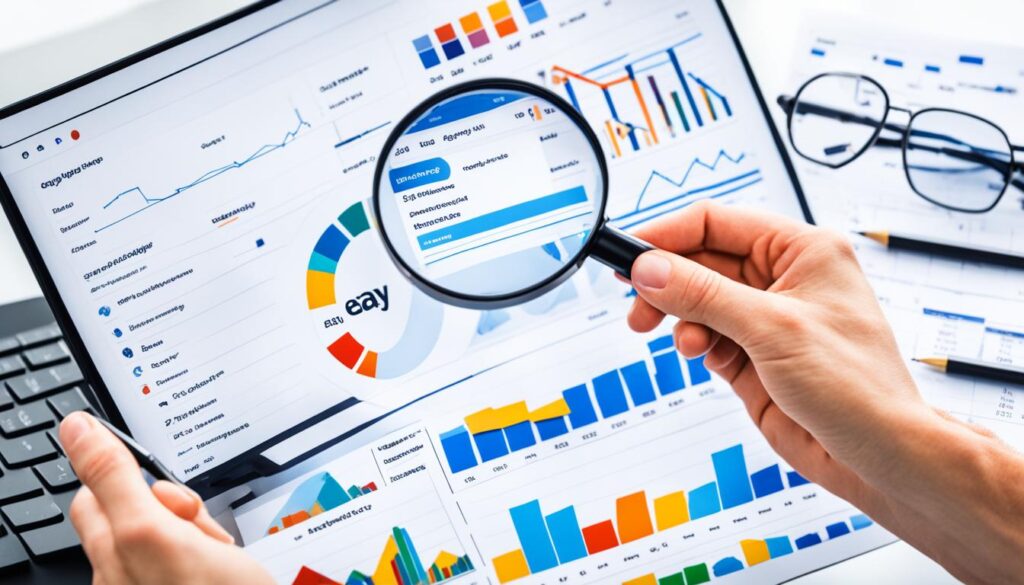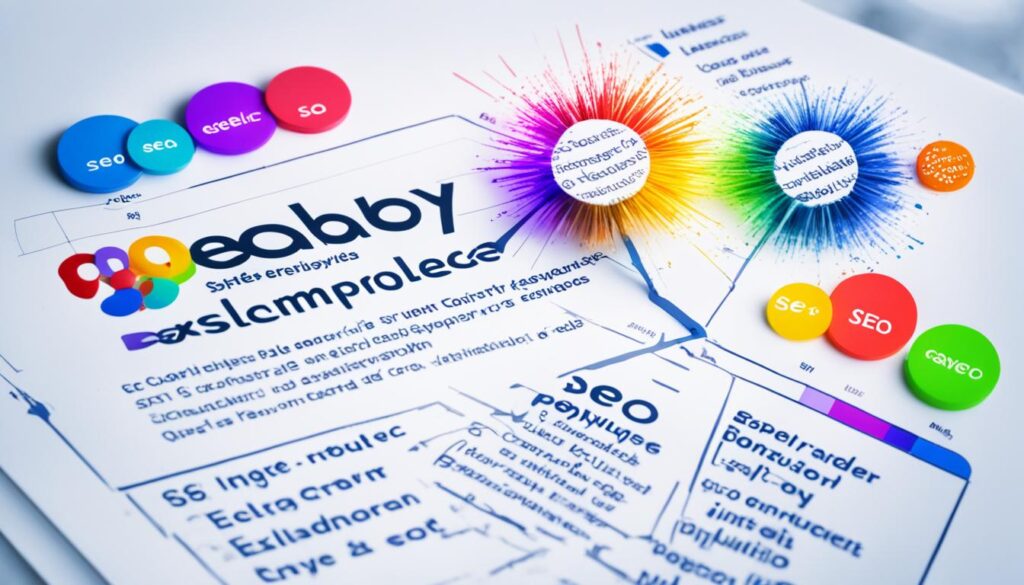eBay is a big marketplace with tons of sales every day. For sellers, it’s a chance to reach many people and grow their business. Yet, finding the best way to list products and get insights can be hard without help. eBay analytics is here to help with that.
This guide will show you how eBay analytics can be a game-changer. You’ll learn to track your sales and performance, get useful insights, and make smart choices to improve your eBay shop. Plus, we’ll share top eBay SEO tips to boost your visibility, draw in more buyers, and up your sales.
If you’re starting out on eBay or you’ve been selling for a while and want to do even better, this guide is for you. Let’s get into it!

Key Takeaways:
- eBay processed over 1.8 billion transactions in 2020, highlighting the immense potential for sellers on the platform.
- eBay analytics provides valuable insights into sales and performance metrics, allowing sellers to make data-driven decisions.
- Optimizing eBay listings with SEO strategies can significantly improve visibility and drive sales.
- eBay offers various reports and metrics to help sellers track their performance and identify opportunities for growth.
- Third-party tools like Zik analytics, AlgoPix, and Putler can enhance eBay analytics capabilities.
What is eBay analytics?
eBay analytics, also known as listing analytics, is a tool eBay offers to sellers. It lets them track how their listings are doing. This tool provides important data that helps sellers with their business, like answering customer questions and forming strategies to boost sales.
With eBay analytics, sellers learn about the rank of their listings and click-through rates. They also see impressions and other key metrics. This information helps them understand how individual listings are performing. They can spot which ones are successful, follow sales growth, and check if they’re meeting their goals.
By using data from eBay analytics, sellers can make smarter decisions to better their listings and sales. They can spot trends, get to know what customers like, and fine-tune their strategies. This tool helps sellers stay ahead in the competitive marketplace by boosting their performance.
Access to these analytics helps sellers monitor their progress and make decisions based on data. They find ways to make their listings better and improve their selling on eBay. For sellers aiming to up their sales and succeed, eBay analytics is crucial.
Reports for sellers within eBay
eBay offers various reports for sellers. These reports help them track sales and monitor performance. They can also analyze website traffic. Let’s look at the important data and metrics in these reports:
Sales Reports
eBay’s sales reports detail each sale, including dates and number of items sold. Sellers see their gross sales, shipping fees, and item costs. They show everything from eBay fees to sales tax. This info helps sellers understand their profits and manage revenue.
Performance Metrics
Performance metrics are also available on eBay. These include traffic data like impression counts and click-through rates (CTR). Sellers can see how engaging their listings are. By using these metrics, sellers can refine their strategies for better results on eBay.
“eBay’s reports provide valuable insights into sales performance, allowing sellers to make informed decisions and maximize their success on the platform.”
Data Analysis
eBay allows for thorough data analysis with their reports. Sellers can examine sales, quantities, and gross sales data. Identifying trends helps sellers adjust strategies to meet customer needs. It’s key for boosting their listings and growing their business.
Historical Data
Historical data is also part of eBay’s reports, letting sellers track progress over time. Comparing past and present sales data helps in spotting growth or dips. This information supports strategic planning and decision-making.
Overall, eBay’s reports give sellers deep insights into their performance. By leveraging this data, sellers can fine-tune their offerings. They can aim for the highest success on the eBay platform.

But, are eBay’s analytics enough?
eBay analytics offer insights into sales and performance. But, they have limitations. These drawbacks prevent full use of eBay data insights. First, eBay’s analytics miss deeper product insights. Sellers get only basic info. This doesn’t offer a full view of customer likes and market trends. It makes it hard to plan for growth and make smart product decisions.
Also, eBay analytics don’t link with other eCommerce activities. Sellers must use only eBay for data analysis. This does not give a full picture of business performance. Not integrating data from different channels makes understanding customers and market trends tough.
Moreover, eBay doesn’t directly give customer insights on the dashboard. Knowing customer behavior and likes is key for good marketing and better customer experience. Missing detailed customer insights means losing chances to connect with your audience and increase sales.
Also, eBay’s analytics only hold data for 90 days. This limits long-term analysis and planning. Sellers might need older data to see long-term trends and assess events or promotions. Making choices based on wider data scopes is vital.
Another issue is the need to download many reports from various places. This is slow and confusing. Trying to understand different business parts at once can lead to mistakes, making it hard to get true insights.
Are you looking for a more comprehensive solution?
If you want better eBay data insights and integration, third-party tools can help. These tools provide deeper product insights and data analysis. They also link with other eCommerce platforms for a fuller view of your business.
Zik Analytics helps find trending and best-selling eBay items. AlgoPix gives marketing insights to improve sales strategies. Putler integrates with eBay for advanced analytics and customer studies. These tools help you get past eBay’s analytics limits.
Don’t settle for eBay’s basic analytics. Use detailed analysis and integration to improve your eBay business.
Get superior eBay analytics with these tools
eBay’s own analytics give useful insights on sales and performance. Yet, there are third-party tools that offer even deeper insights. These tools bring advanced features for market and competitor research, product and marketing insights, and eCommerce reports.
Zik analytics
Zik analytics is great for eBay sellers. It shows trending and top-selling items, helping to find profitable niches. Sellers get detailed data on sales, competition, and demand trends. This tool helps sellers stand out and boost their eBay sales.
AlgoPix
AlgoPix gives key data for marketing strategies on eBay. It has competitor and demand analysis, helping sellers understand market trends. With AlgoPix, sellers learn about their audience, improve listings, and increase sales.
Putler
Putler combines eBay analytics in its eCommerce reporting tool. It offers a full view of sales, customer segmentation, and products. Sellers can check marketing effectiveness, identify top products, and make informed decisions.
Using these third-party tools can open growth opportunities on eBay. They give sellers a broader view of their business and market. With these tools, sellers can discover profitable products, study competitors, or manage eCommerce data better. This helps in making better decisions and improving eBay business.
So, which one should you choose?
Choosing the right eBay analytics tool requires thought. Think about what your business needs. Here are some factors to think about:
Detailed Reports
Find a tool that shows detailed reports. It’ll help you see how you’re doing on eBay. The reports should cover sales, visitors, and how customers behave.
Historical Data
It’s key to have access to past data. This lets you see how your listings did over time. Pick a tool that lets you look back and plan ahead.
Segmentation and Drilldowns
Being able to break down your data is crucial. Look for a tool that lets you categorize data in different ways. It’ll help you see trends and focus on certain customer groups.
Intuitive Insights
Choose a tool that makes data easy to understand. Visuals like charts and graphs can quickly show you what’s going on. This way, you can spot trends at a glance.
Product Reports and Customer Insights
Think about a tool that offers insights on both products and customers. Understanding how products perform and what customers like is beneficial.
Google Analytics Integration
Having your tool work with Google Analytics is a plus. It gives you a wider view of your online business. Look for this feature to track your success on different fronts.
Managing Multiple Stores and Multichannel Support
If you have more than one eBay store or sell on various platforms, find a tool that can manage it all. This makes handling your data simpler and supports your multichannel strategy.
To choose the best eBay analytics tool, think about these areas. The right tool will match your goals and provide detailed insights, historical views, data breakdowns, easy-to-understand insights, detailed product and customer analysis, Google Analytics integration, and the ability to manage various stores and channels effectively.

| Feature | Description |
|---|---|
| Detailed Reports | Comprehensive insights into sales, traffic, and customer behavior. |
| Historical Data | Access and analyze past performance data for strategic planning. |
| Segmentation and Drilldowns | Ability to categorize and analyze data based on various parameters. |
| Intuitive Insights | Clear visualizations and intuitive interpretations of data. |
| Product Reports and Customer Insights | Analyze product performance and gain insights into customer behavior. |
| Google Analytics Integration | Seamless integration with Google Analytics for a holistic view of eCommerce activities. |
| Managing Multiple Stores and Multichannel Support | Capability to handle multiple accounts and support selling across multiple channels. |
The bottom line of eBay analytics
eBay analytics help sellers make smart choices, boost sales, and plan their growth. Using eBay’s insights gives sellers an edge and makes customers happier.
Benefits of eBay analytics
Data-driven decisions are a major plus of eBay analytics. Sellers see what works and what doesn’t by looking at sales data. They can tweak their listings and marketing to sell more and make more money.
Strategic planning gets easier with eBay analytics too. Sellers know which products do well and how their ads perform. They can plan better ways to grow on eBay with this info.
This tool also gives sellers a lead over their rivals. By keeping an eye on sales and market trends, they can quickly adjust. This quick action helps them grow and beat the competition.
Finally, eBay analytics boost how happy customers are. By understanding what buyers like, sellers can offer just what they want. This means happier customers who keep coming back.
eBay SEO strategies for optimizing listings
Sellers can use eBay analytics and SEO strategies to boost their listing’s visibility. These methods help improve the performance and reach of their listings on eBay. Let’s explore some vital SEO strategies for eBay:
1. Conduct Keyword Research:
Start with thorough keyword research to find relevant, high-demand keywords. Then, use these keywords in your listing to draw in the right buyers.
2. Optimize Titles:
Make sure your eBay listing titles include key descriptors of your product. Titles should be clear, concise, and engaging to attract buyers.
3. Craft Detailed and Compelling Item Descriptions:
Create item descriptions that fully describe your product. Include keywords in a natural way. Make sure the text is easy to read and offers useful information.
4. Utilize Product Specifics:
Use eBay’s product specifics feature to show up in specific searches. Provide complete product details like brand, size, and color. This helps meet searchers’ specific needs.
5. Optimize Images for Visual Appeal:
Use high-quality images to make your listings stand out. Ensure images are the right size and resolution. Add keywords to the image’s alt tag to improve SEO.

6. Select the Right Categories and Sub-Categories:
Choose the right category for your product to improve search accuracy. Finding the best category helps buyers discover your listings more easily.
7. Price Competitively:
Set competitive prices to attract more buyers. Research market trends and competitor pricing before setting your price.
8. Offer Fast and Free Shipping:
Providing fast and free shipping can draw in more buyers. Think about offering these shipping options to enhance buyer experience.
9. Maintain Positive Customer Feedback and Ratings:
Good feedback and ratings are key to winning buyers’ trust. Offer great service, solve problems quickly, and encourage reviews to improve your visibility.
These eBay SEO tips help sellers enhance their listings. By using them, you can increase visibility and boost your sales on the platform.
Conclusion
eBay analytics and eBay SEO strategies are key for sellers. They help track sales and optimize listings. This leads to better performance on the platform.
By using eBay analytics, sellers can see how they’re doing. This allows them to make smart moves to grow their business. Applying SEO best practices also makes their listings more visible. This can bring in more sales and success.
Sellers need to keep an eye on their analytics and update their strategies. Staying current with trends and features is crucial. This way, they can find areas to improve and seize new chances to advance.
Furthermore, knowing the ins and outs of eBay SEO keeps sellers ahead of the competition. It helps them make the most of their opportunities.
Using these tools right can deeply understand their performance. It lets sellers make the right calls and reach new levels with their eBay business.